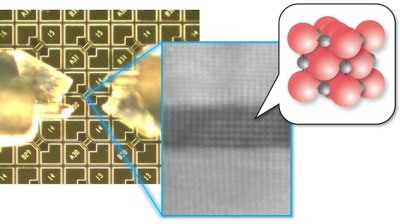A paper by Dr. Thomas Scheike et al. published Appl. Phys. Lett. has been selected as a Featured Article and published as a news article of American Institute of Physics research highlight “Scilight.
2021.02.01
A paper entitled "Exceeding 400% tunnel magnetoresistance at room temperature in epitaxial Fe/MgO/Fe(001) spin-valve-type magnetic tunnel junctions" published in Applied Physics Letters by Dr. Thomas Scheike, a post-doc researcher in Spintronisc Group, et al. has been selected as a Featured Article of Applied Physics Letters. The paper also selected as a Scilight, research highlight article of American Institute of Physics.
“Exceeding 400% tunnel magnetoresistance at room temperature in epitaxial Fe/MgO/Fe(001) spin-valve-type magnetic tunnel junctions”
Thomas Scheike, Qingyi Xiang, Zhenchao Wen, Hiroaki Sukegawaa), Tadakatsu Ohkubo, Kazuhiro Hono, and Seiji Mitani, Appl. Phys. Lett. 118, 042411 (2021).
https://doi.org/10.1063/5.0037972
(Preprint:https://arxiv.org/abs/2011.08739)
AIP Scilight
“Researchers double room temperature tunnel magnetoresistance ratios of Fe/MgO/Fe”
https://doi.org/10.1063/10.0003487
“Exceeding 400% tunnel magnetoresistance at room temperature in epitaxial Fe/MgO/Fe(001) spin-valve-type magnetic tunnel junctions”
Thomas Scheike, Qingyi Xiang, Zhenchao Wen, Hiroaki Sukegawaa), Tadakatsu Ohkubo, Kazuhiro Hono, and Seiji Mitani, Appl. Phys. Lett. 118, 042411 (2021).
https://doi.org/10.1063/5.0037972
(Preprint:https://arxiv.org/abs/2011.08739)
AIP Scilight
“Researchers double room temperature tunnel magnetoresistance ratios of Fe/MgO/Fe”
https://doi.org/10.1063/10.0003487

[Overview]
Thomas Scheike, Postdoctoral Fellow, Hiroaki Sukegawa, Principal Researcher (Spintronics Group) and coauthors achieved a 417% tunnel magnetoresistance (TMR) ratio at room temperature using an iron (Fe)/magnesium oxide (MgO)/Fe magnetic tunnel junction. This TMR ratio is almost twice as large as the reported values in the Fe/MgO/Fe structure. The Fe/MgO/Fe structure has been used as a standard magnetoresistive devices in spintronics researches for nearly 20 years because of its very simple structure. However, the room-temperature TMR ratio, which is required to be large for practical devices, has remained around 200% for a long time; therefore, no significant progress was expected in a short time.
This achievement was realized by improving the crystal quality of the interface region where the Fe and MgO layers contact using the single crystal thin film fabrication technique developed by the authors. Especially, the improvement of both the upper and lower interfaces at the same time significantly contributed to the observation of the giant TMR ratio. Furthermore, the authors have achieved an even higher room-temperature TMR ratio of 496% by introducing a cobalt-iron alloy as an ultra-thin layer at the bottom interface. This value is the record as a magnetic tunnel junction with a pined layer (exchange-biased layer), which is necessary for many practical device structures. Considering that the TMR ratios of current practical devices are around 300% at best, these observed values are extremely large. A TMR ratio at low temperature exceeds 900%, which almost reaches the theoretical prediction values.
This study demonstrated that there is still much room for evolution in magnetic tunnel junctions since the extraordinary progress has been achieved even in the common Fe/MgO/Fe, which was considered to be an old-fashioned device in the spintronics research field. Device design based on the findings of this study will open up the possibility of realizing even larger TMR ratios, which is expected to accelerate researches of spintronic applications such as large-capacity non-volatile magnetic memory and highly-sensitivity magnetic sensors.
(Hiroaki Sukegawa)
This achievement was realized by improving the crystal quality of the interface region where the Fe and MgO layers contact using the single crystal thin film fabrication technique developed by the authors. Especially, the improvement of both the upper and lower interfaces at the same time significantly contributed to the observation of the giant TMR ratio. Furthermore, the authors have achieved an even higher room-temperature TMR ratio of 496% by introducing a cobalt-iron alloy as an ultra-thin layer at the bottom interface. This value is the record as a magnetic tunnel junction with a pined layer (exchange-biased layer), which is necessary for many practical device structures. Considering that the TMR ratios of current practical devices are around 300% at best, these observed values are extremely large. A TMR ratio at low temperature exceeds 900%, which almost reaches the theoretical prediction values.
This study demonstrated that there is still much room for evolution in magnetic tunnel junctions since the extraordinary progress has been achieved even in the common Fe/MgO/Fe, which was considered to be an old-fashioned device in the spintronics research field. Device design based on the findings of this study will open up the possibility of realizing even larger TMR ratios, which is expected to accelerate researches of spintronic applications such as large-capacity non-volatile magnetic memory and highly-sensitivity magnetic sensors.
(Hiroaki Sukegawa)

